BETWEEN 1943 and 1945, Tracy Layton’s father landed on the beaches of Tarawa, Saipan, Tinian and Okinawa. Today, in 2025, she made an emotional pilgrimage to Saipan and Tinian to see what her father saw and to imagine how he must have felt.
Afterwards, I sat for an interview with her at Saipan’s Grandvrio Hotel in Garapan.
Walt: Why are you here on Saipan?
Tracy: I wanted to come and visit Saipan and Tinian, which was where my dad fought in World War II. His name was Joe Goggin. He was in the Second Marines, and I just wanted to see where he was. This was a great opportunity for me to see it.
Walt: We determined that he was in the Second Marines and that he likely landed on Red Beach, based on the information we’ve gathered. When you were growing up, were you aware of your father’s role in history? Did he talk about it? How did you discover what he did?
Tracy: I remember sitting with my mom, sister, and dad at the kitchen table. We knew he was a Marine, but he didn’t talk about it much. He would share snippets, but he never went into great detail. I was born in 1960, and in the 1960s, he didn’t really want to share much about his time in the military. One thing I do remember, however, is that he told the family what he was taught to say in Japanese [after the Battle of Saipan]: “Come out of the caves.”
He was very dedicated to the safety of Americans, and he was proud of his service. But he didn’t really want to go into too much detail with my sister, my mom and me when we were kids.
Walt: You also mentioned that he did several tours before and after Saipan?
Tracy: That’s correct. His first landing was in Tarawa, then he came to Saipan and then Tinian, and later went on to Okinawa. He was wounded in Okinawa right at the very end of the battle. He always said, “Oh, it’s the luck of the Irish!” It was just at the very end, and he was seriously wounded. He was then sent back home to San Francisco.
One thing I always found interesting was that he was never a smoker, and when he got his rations — which included cigarettes — he always traded them for chocolate. But when he was in the military hospital near San Francisco, nurses would bring cigarettes, and out of sheer boredom he started smoking. We always found it ironic that it was nurses who got him smoking, but he later quit cold turkey with sheer determination.
Walt: And was that the only war he fought in?
Tracy: Not exactly. He was discharged with a disability after Okinawa, but when the Korean War started, he was called back [1950s]. He was sent to Camp Lejeune in South Carolina, where he trained new recruits. So, he never actually went to Korea. I recall he found the training work somewhat boring compared to his combat experience. That was the end of his military service.
Walt: He enlisted right after Pearl Harbor, correct?
Tracy: Yes, he was born in April of 1926, so after Pearl Harbor, he was 15, and he actually enlisted at 15 years old. I think of myself as a 15-year-old, and I can’t even imagine doing such a thing. But, you know, he was cut from a different cloth. I don’t know that I could have done that, but he did, and I also think he wasn’t alone. He, in a sense, almost forced his parents to sign a waiver. And he went to boot camp down in San Diego, I believe, and along with a lot of other guys. So when he was fighting here on Saipan, he was only 18. I believe that when guys enlisted after Pearl Harbor, they were supposed to be 18 years old, but I think a lot of times the draft officers overlooked some of the ages of the guys. He often said, “I went in a tough kid, and I came out a man,” and I think all the Marines went through that. He started out in California, went to New Zealand, and then on to Tarawa. From what I learned, the guys that got on the ships — they never really knew until the last moment what their mission was.
Walt: Before coming to Saipan, what did you know about the island based on what your father had told you?
Tracy: One thing he vividly remembered — and I vividly remember him talking about — was the sugarcane. He said it was so difficult to maneuver through because it was so sharp. It cut through his uniform and tore at his skin.
He also talked about Mount Tapotchau. He said it was about 1,500 feet high but felt like 15,000 feet. The battle was so tough, and the climb seemed endless.
As we got older and had our own families, his grandkids became interested, and he became more open about sharing his experiences. By the late ’90s and early 2000s, he talked about it more. He never had any regrets about anything he did. It was his duty. It was his mission, and he was such a proud man to do what he did, to help the U.S. do what they needed to do.
Walt: Now you’ve finally made the pilgrimage here to see where he landed. We did a two-day tour of the landing beaches on Saipan and Tinian. What struck you compared to what you expected?
Tracy: I can’t believe what he did. The hardships — he was not a big guy — about 5’6″, maybe 130 or 140 pounds. And he carried a Browning Automatic Rifle, a heavy weapon. I don’t know how he did it. The heat, the humidity, being shot at — I don’t know how he had the strength and mental fortitude to keep going.
Walt: And yet, he endured all of that so that you wouldn’t have to.
Tracy: That’s true. He and my mom gave my sister and me, and later our kids, an amazingly wonderful life, and for that I feel incredibly grateful.
Walt: What did you think of Saipan?
Tracy: When I first arrived, I noticed how rugged the terrain is. Seeing the mountains and the layout of the island, I can’t fathom how the Marines and Army managed to take it. The Japanese had it so well fortified, and they [the Japanese soldiers] knew how critical it was to hold onto the island. I don’t know how the Americans did it — but they did. It amazes me.
Walt: And after touring the island?
Tracy: As I see it today, it’s amazing! I look at everything here, this beautiful hotel that I’m in, and as you drove me around the island, it’s beautiful. The people are so friendly. People will ask me, “Why are you here?” And I’ll tell them; and when I say “I’m here because my dad was here. He was part of the second Marines,” they light up, and say, “Oh, we’re so grateful. We’re so grateful,” and that makes me feel very proud, and that just makes me kind of beam with pride for my dad.
Walt: Thank you for sharing your father’s story. Is there anything you’d like to add?
Tracy: I’m just so grateful that I was able to come and see the island. I wanted to bring some things back for my family, because I’m not sure if they’ll ever be here. But as I go into some of the stores, everything I see says “I Love Saipan,” and I didn’t think I could purchase anything that says “Love Saipan,” because I don’t think my dad loved Saipan. He didn’t. He was at war here, but as he left, what he did was so critical. He and the other Marines and all the members of the military — what they did was so critical to the success of the whole operation…
Walt: And he suffered so that there could, in fact, be a period of time where people could love Saipan. He suffered specifically —and indirectly — to make Saipan what it is today.
Tracy: Yes, and so I do have a different viewpoint. And that’s important too, absolutely.
Oh, and thank you, Walt, for a wonderful tour. I learned so much, not only about the military operation, but about the beautiful islands and how they’ve progressed since the war years. Really important. Thank you so much. I was fortunate enough to get to see John Castro in the Seafaring Traditions Project, where he was working with local youth to show them basket making and canoe construction, which I think is wonderful because it’s so important to carry on the traditions of the elders, to pass on to the youngsters, so critical. So thank you to John for letting me observe. I cannot say enough about how great and how phenomenal this tour was, and I thank you, Walt, from the bottom of my heart for sharing your extensive and thorough knowledge of what happened here. And I so appreciate it and will never forget these two days. I will never forget it.
Originally from Jamaica, West Indies, Walt F.J. Goodridge is an author and nomadpreneur living on Saipan. View similar pilgrimage interviews on his Youtube channel https://youtube.com/@discoversaipan

Tracy Layton with the author, Walt Goodridge.
Contributed photo

Tracy Layton at Yellow Beach Saipan.
Contributed photo

Tracy Layton at White Beach on Tinian.











